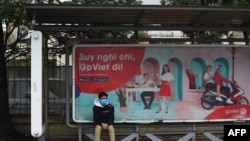Ho Chi Minh City is building a bus rapid transit system, in hopes of weaning Vietnam's public away from their increasingly complex menu of transport choices.
Residents can hail cabs, motorbike taxis, or the Uber of Southeast Asia, Grab. Some can afford cars, and the occasional tourist hires a cyclo pedicab. Grab used to offer a carpool service, and another business, GoDee, lets customers book a cheap spot in a shared van at regular intervals.
The government wants people to use more public transportation, but Hanoi and Ho Chi Minh City subway construction has been repeatedly delayed, and conventional buses are slow and unpredictable, which has led to the initiation of the new effort.
Under the new system, Ho Chi Minh City would create dedicated lanes for electric buses, partly by renovating current roads and partly by adding lanes elsewhere. The buses are expected to save commuters time by bypassing traffic cars and running more frequently than conventional buses. Officials, who did not give a date for the system's debut, said the new system would reduce traffic and pollution. They hope the new system will attract new riders, such as office workers, in addition to the students and blue-collar workers who now use mass transit.
Some observers are not sure the city can afford the $137 million price tag, but the system is supposed to speed transport by dedicating parts of city streets to public buses.
“The project will demonstrate considerable economic, environmental and social benefits, and guide urban development toward more sustainable patterns in Ho Chi Minh City,” Ivo Sieber, Switzerland's ambassador-designate to Vietnam, said. His government is funding part of a grant for the transit system.
Tech and transit
This move is just the latest example of city planners around the world trying to improve public transportation attracting more passengers to cut traffic and pollution while staying within a budget. Nearby Shanghai and Singapore have tried out “on-demand buses,” an arrangement under which riders book through a phone app and then a route is calculated to pick up as many people as possible most efficiently.
Tech startups have begun to enter the fold, paving the way for more data collection, which city planners can use to analyze traffic patterns, calculate routes, and choose the best modes of transit.
Uber, when it operated in Vietnam, said it would work with city planners to analyze exactly this kind of data. Grab bought out Uber in 2018. At the same time, critics say ridehailing has worsened traffic in Vietnam and elsewhere because more people are hiring private rides instead of taking public transportation.
Some still expect ride hailing to supplement, rather than replace, public transportation, allowing people to use a bus or train for most of their commute, then hail a ride at the end.
Vietnam aims for “measures to maximize connectivity and ridership while also providing last mile connections, such as feeder bus services to carry people to and from the nearest bus station along the new line,” the World Bank office in Hanoi said in a press release. It is also funding part of the grant for the new bus rapid transit system in Ho Chi Minh City. The bank said the system would improve mobility by adding to an “integrated” transit system around the city that gives riders more options. This includes mixing rapid and traditional buses, private rides, and eventually a subway.
Ho Chi Minh City's goal for the new rapid bus system is to reduce pollution and traffic, both of which have become worse in recent years.
The city's population reached nearly 9 million in the 2019 census, up 1.8 million since 2009, on the same number of roads as a decade ago.
City officials have not given a precise breakdown of the $137 million to be spent on the rapid buses, but the money will be used to buy electric buses, build dedicated lanes for the buses with LED street lights and street cameras, and train transport officials.




